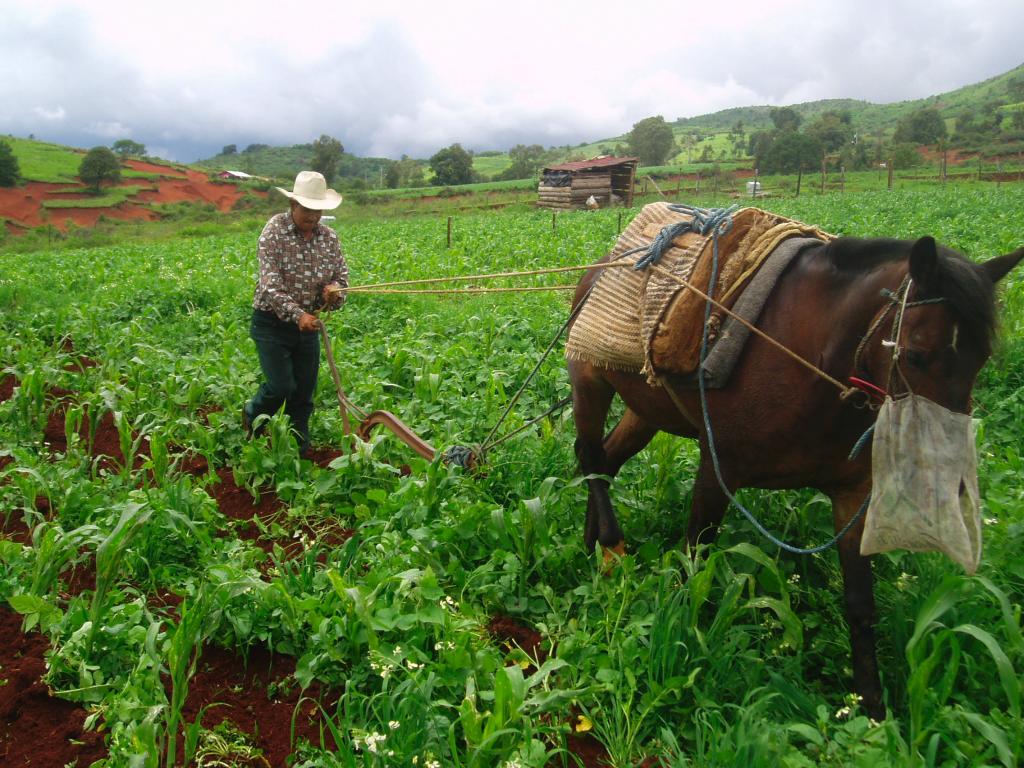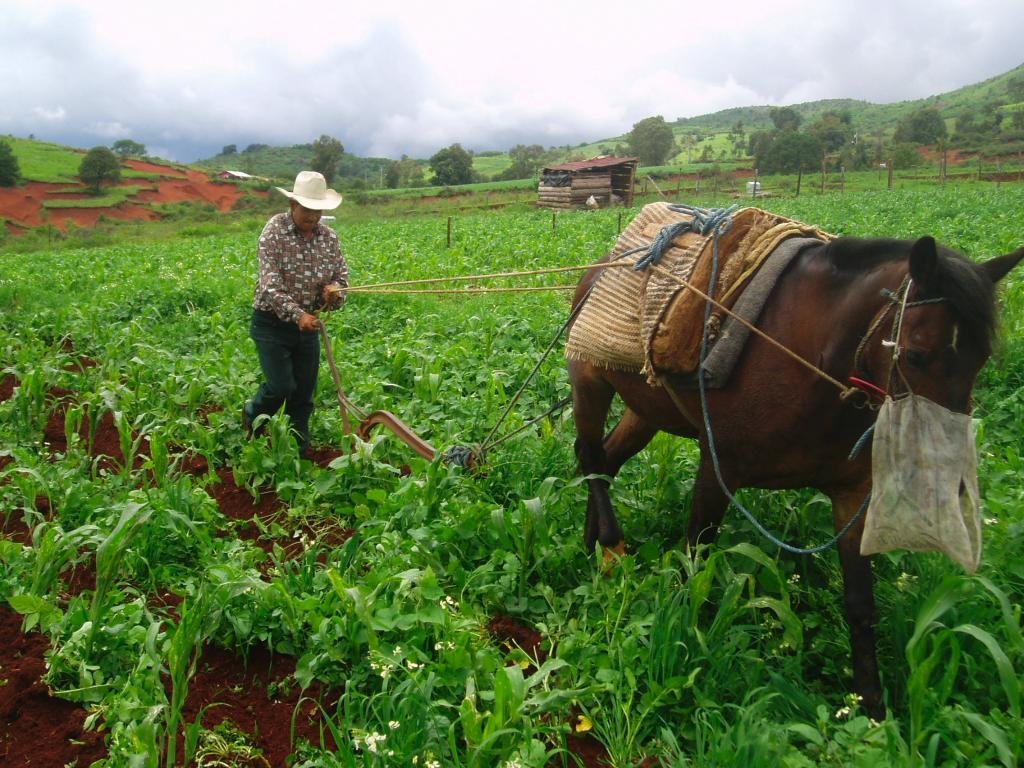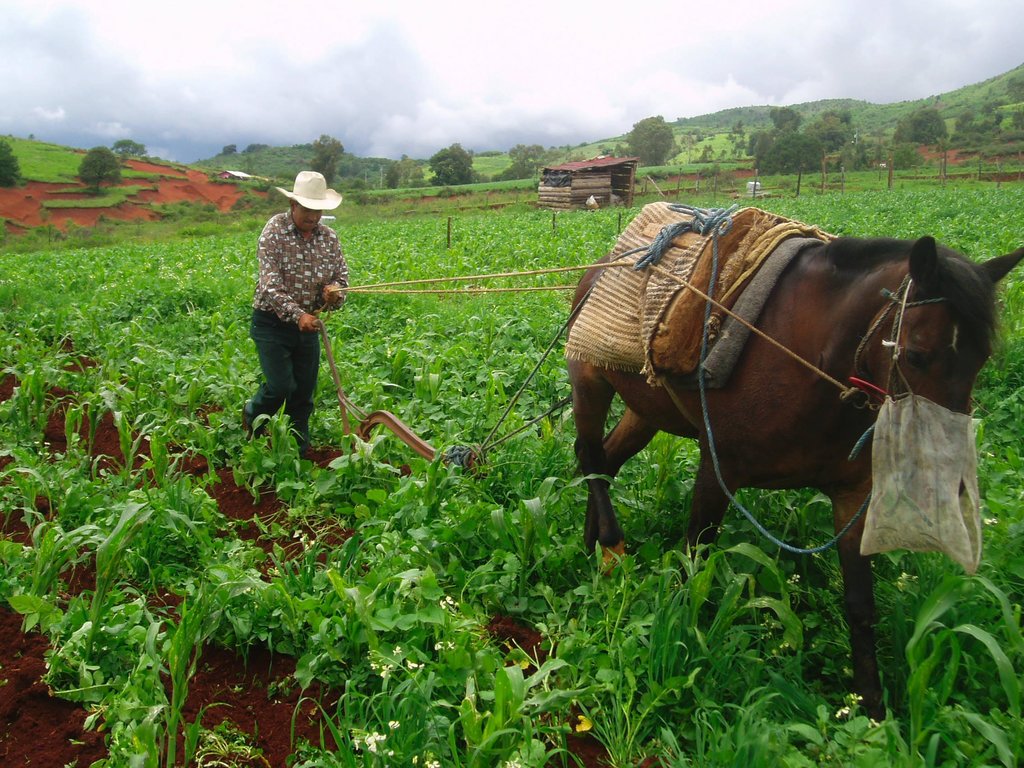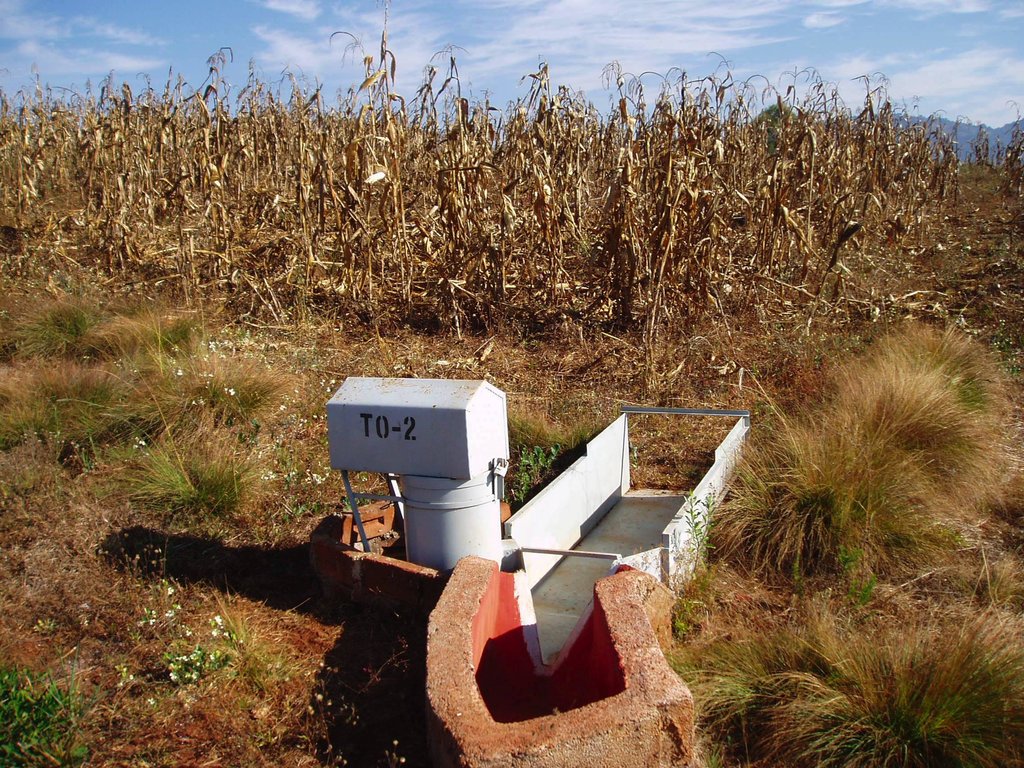Residue management of anual crop of maize/bean association [ប្រទេសម៉ិកស៊ិក]
- ការបង្កើត៖
- បច្ចុប្បន្នភាព
- អ្នកចងក្រង៖ Christian Prat
- អ្នកកែសម្រួល៖ –
- អ្នកត្រួតពិនិត្យ Fabian Ottiger
Manejo de rastrojo de cultivo anual de la asociación maiz/frijol
approaches_2579 - ប្រទេសម៉ិកស៊ិក
ពិនិត្យមើលគ្រប់ផ្នែក
ពង្រីកមើលទាំងអស់ បង្រួមទាំងអស់1. ព័ត៌មានទូទៅ
1.2 ព័ត៌មានលម្អិតពីបុគ្គលសំខាន់ៗ និងស្ថាប័នដែលចូលរួមក្នុងការវាយតម្លៃ និងចងក្រងឯកសារនៃវិធីសាស្ត្រផ្សព្វផ្សាយ
ឈ្មោះអង្គភាពមួយ (ច្រើន) ដែលបានចងក្រងឯកសារ/ វាយតម្លៃលើវិធីសាស្ត្រផ្សព្វផ្សាយ (បើទាក់ទង)
Institut de recherche pour le développement IRD (Institut de recherche pour le développement IRD) - ប្រទេសបារាំង1.3 លក្ខខណ្ឌទាក់ទងទៅនឹងការប្រើប្រាស់ទិន្នន័យដែលបានចងក្រងតាមរយៈវ៉ូខេត
អ្នកចងក្រង និង(បុគ្គលសំខាន់ៗ)យល់ព្រមទទួលយកនូវលក្ខខណ្ឌនានាទាក់ទងទៅនឹងការប្រើប្រាស់ទិន្នន័យដែលបានចងក្រងតាមរយៈ វ៉ូខេត:
បាទ/ចា៎
1.4 ការយោងមួយ (ច្រើន) ទៅលើ (កម្រង) បញ្ជីសំណួរនៃបច្ចេកទេស SLM
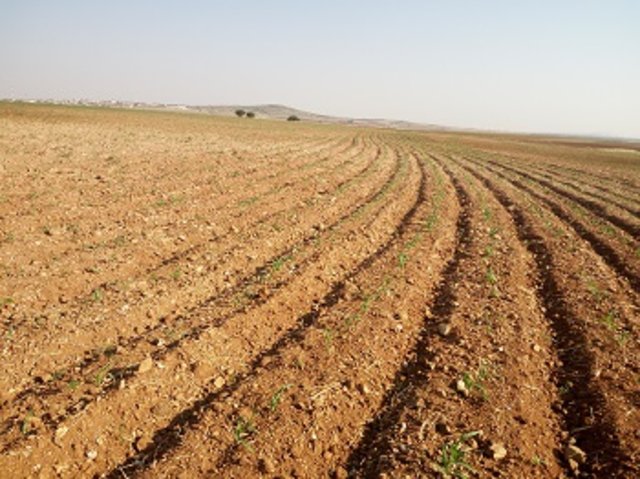
Sistemas de prácticas de MST en suelos con … [ប្រទេសម៉ិកស៊ិក]
El sistema de prácticas de MST en planicie con pendiente no mayores del 5%, la cual consiste en la rotación de cultivos en dos ciclos denominados primavera-verano y otoño-invierno, donde en una parcela de 5 hectáreas se combinan frijol-avena y maíz-calabaza y triticale. Para el caso de la rotación frijol-avena, …
- អ្នកចងក្រង៖ Alejandra Castillo
2. ការពណ៌នាអំពីវិធីសាស្ត្រផ្សព្វផ្សាយ SLM
2.1 ពណ៌នាសង្ខេបខ្លីពីវិធីសាស្ត្រផ្សព្វផ្សាយ
Maize residue management with high input of crop residues and annual crop instead of year one crop and fallow in year 2
2.2 ពណ៌នាលម្អិតពិវិធីសាស្ត្រផ្សព្វផ្សាយ
ពណ៌នាលម្អិតពិវិធីសាស្ត្រផ្សព្វផ្សាយ:
Aims / objectives: The objetive is to evaluate the influence of different agronomic systems including conventional system (one year tillage and one year fallow), conservation system (high input of crop residues) with mineral fertilizers every year, conservation system (high input of crop residues) with organic fertilizer every year on: water run-off (quantity and quality), soil sediment transports, soil water content, soil cover, carbon capture, soils characteristics and their interactions with the production of the maize/bean crop association on Acrisol
Methods: Primary tillage for maize/beans it consisted in moldboard ploughing and furrowing, and one post-emergence weeding was done manually. Depth of tillage for moldboard plow was about 0.20m and for rototill, about 0.15 m. 3 seeds of corn or beans are planted and covered by foot. Fertilizer is put on the depression just after seeding and one month later during the post emergence weeding. This experiment have been done on Acrisol
Stages of implementation: The experiment is finished. Dissemination to the stakeholders and policy makers has been done. Policy makers took the results and are disseminating it to the other stakeholders
Role of stakeholders: Active. Visit to the field experiment site during the experimentation, workshops, etc...but the adoption of the technologies can be effective only if the system is deeply change. Farmers need thei fallow year for their animals. This proposal is just one element of the whole system to change.
Other important information: Important results to understand and measure the soil erosion and run-off with this kind of soil (Acrisol) with the traditionnal and improaved cultural system
2.3 រូបភាពនៃវិធីសាស្ត្រផ្សព្វផ្សាយ
2.5 ប្រទេស/តំបន់/ទីតាំងកន្លែង ដែលវិធីសាស្ត្រផ្សព្វផ្សាយត្រូវបានអនុវត្តន៍
ប្រទេស:
ប្រទេសម៉ិកស៊ិក
តំបន់/រដ្ឋ/ខេត្ត:
Mexico/Michoacán
បញ្ជាក់បន្ថែមពីលក្ខណៈនៃទីតាំង:
Morelia
2.6 កាលបរិច្ឆេទនៃការចាប់ផ្តើម និងបញ្ចប់នៃវិធីសាស្រ្តផ្សព្វផ្សាយនេះ
សូមបញ្ជាក់ឆ្នាំដែលបានបង្កើតឡើង:
2002
ឆ្នាំបញ្ចប់ (ប្រសិនបើវិធីសាស្ត្រផ្សព្វផ្សាយត្រូវបានឈប់ប្រើប្រាស់):
2008
2.7 ប្រភេទនៃវិធីសាស្ត្រផ្សព្វផ្សាយ
- ផ្អែកលើគម្រោង/កម្មវិធី
2.8 គោលបំណង/ទិសដៅសំខាន់នៃវិធីសាស្ត្រផ្សព្វផ្សាយ
The Approach focused on SLM only (Soil conservation, water conservation, crop residue management, organic fertilizers, maize/bean association)
The area is strongly eroded and it was necessary to understand which factors could explain this situation and try agronomic alternatives to proposed to farmers to reduce it. In fact soil erosion is mainly due to the cattle free grazing in the field during the fodder and in commune land use for other part. The elimination of fodder year reduce presence of animals and increase production/productivity which can be given to the cattle. But this means to have less animals, more works and normally, more beneficits!
The SLM Approach addressed the following problems: Culivating every year means less space for the cattle which are the base of the agricultural system. the adoption of the technologies can be effective only if the system is deeply change. Farmers need the fallow year for their animals. This proposal is just one element of the whole system to change. New practice generates psychological resistance
2.9 លក្ខខណ្ឌអនុញ្ញាត ឬរារាំងការអនុវត្តន៍បច្ចេកទេសដែលស្ថិតនៅក្រោមវិធីសាស្រ្តផ្សព្វផ្សាយ
សង្គម/វប្បធម៌/ និងតម្លៃនៃសាសនា
- រារាំង
New practice generates psychological resistance
Treatment through the SLM Approach: Visit farmers using the new practice is very effective to convince other farmers
ភាពអាចរកបាននៃធនធានហិរញ្ញវត្ថុ និងសេវាកម្ម
- រារាំង
Actually, farmers need the fallow year for their animals.
Treatment through the SLM Approach: Follow research to complete the whole agricultural system to be able to make a global proposal which will give much more money to live, and not to survive
ចំណេះដឹងស្តីពី SLM និងការទទួលបានការគាំទ្រផ្នែកបច្ចេកទេស
- រារាំង
Treatment through the SLM Approach:
ទំហំការងារ ភាពអាចរកបាននៃកម្លាំងពលកម្ម
- រារាំង
Means to work the double because farmers will have all their land to work, without any fallow
Treatment through the SLM Approach: Follow research to complete the whole agricultural system to be able to make a global proposal which will give much more money to live, and not to survive
3. ការចូលរួម និងតួនាទីរបស់ភាគីពាក់ព័ន្ធ
3.1 អ្នកពាក់ព័ន្ធដែលបានចូលរួមក្នុងវិធីសាស្ត្រផ្សព្វផ្សាយ និងតួនាទីរបស់ពួកគេ
- អ្នកប្រើប្រាស់ដីក្នុងតំបន់/សហគមន៍
Atecuaro community
Men are more involucrate in tillage activities. Men perform hard labor job in the land, while women participate in the household tasks. Nearly all the farmers of the communities are poor!
- អ្នកឯកទេសគ្រប់គ្រងដីប្រកបដោយចីរភាព/ទីប្រឹក្សាបច្ចេកទេសកសិកម្ម
- រដ្ឋាភិបាលថ្នាក់ជាតិ (អ្នករៀបចំផែនការ អ្នកសម្រេចចិត្ត)
INIFAP (Mex. Agronomic Res.Inst.), COLPOS (Col. Postgraduate of agriculture), UNAM-CIEco, SEMARNAT (Sec. Environment)
- អង្គការអន្តរជាតិ
UE project (REVOLSO then DESIRE), IRD (France), CSIC (Spain)
3.2 ការចូលរួមរបស់អ្នកប្រើប្រាស់ដីក្នុងតំបន់/ សហគមន៍ក្នុងតំបន់ក្នុងដំណាក់កាលផ្សេងគ្នានៃវិធីសាស្រ្តផ្សព្វផ្សាយ
| ការចូលរួមរបស់អ្នកប្រើប្រាស់ដីក្នុងតំបន់/សហគមន៍ក្នុងតំបន់ | សូមបញ្ជាក់នរណាត្រូវបានចូលរួម ព្រមទាំងពណ៌នាសកម្មភាពទាំងនោះ | |
|---|---|---|
| ការចាប់ផ្តើម/ការលើកទឹកចិត្ត | ការគាំទ្រពីខាងក្រៅ | |
| ការរៀបចំផែនការ | ការគាំទ្រពីខាងក្រៅ | |
| ការអនុវត្តន៍ | ការគាំទ្រពីខាងក្រៅ | |
| ការត្រួតពិនិត្យ និងវាយតម្លៃ | អន្តរកម្ម | |
| Research | អន្តរកម្ម |
3.4 ការសម្រេចចិត្តលើការជ្រើសរើសបច្ចេកទេស SLM
សូមបញ្ជាក់តើអ្នកណាជាអ្នកបានសម្រេចចិត្តក្នុងការជ្រើសរើសបច្ចេកទេសដើម្បីយកមកអនុវត្តន៍:
- អ្នកជំនាញឯកទេស SLM បន្ទាប់ពីបានប្រឹក្សាយោបល់ជាមួយអ្នកប្រើប្រាស់ដី
ចូរពន្យល់:
Decisions on the method of implementing the SLM Technology were made by mainly by SLM specialists with consultation of land users
4. ជំនួយបច្ចេកទេស ការកសាងសមត្ថភាព និងការគ្រប់គ្រងចំណេះដឹង
4.1 ការកសាងសមត្ថភាព/ បណ្តុះបណ្តាល
តើវគ្គបណ្តុះបណ្តាលបានផ្តល់ឱ្យអ្នកប្រើប្រាស់ដី/អ្នកពាក់ព័ន្ធផ្សេងៗទៀតដែរឬទេ?
បាទ/ចា៎
សូមបញ្ជាក់តើអ្នកណាត្រូវបានបណ្តុះបណ្តាល:
- អ្នកប្រើប្រាស់ដី
- បុគ្គលិកចុះទីវាល/អ្នកផ្តល់ប្រឹក្សាយោបល់
- Institutions
ទម្រង់នៃការបណ្តុះបណ្តាល:
- អនុវត្តន៍ជាមួយការងារ
- ពីកសិករទីកសិករ
- ទីតាំងបង្ហាញ
- ការប្រជុំជាសាធារណៈ
4.2 សេវាផ្តល់ប្រឹក្សាយោបល់
តើអ្នកប្រើប្រាស់ដីបានទទួលនូវសេវាផ្តល់ប្រឹក្សាដែរ ឬទេ?
បាទ/ចា៎
ពណ៌នា/ពន្យល់:
Advisory service is quite adequate to ensure the continuation of land conservation activities
4.4 ការត្រួតពិនិត្យ និងវាយតម្លៃ
តើការត្រួតពិនិត្យ និងវាយតម្លៃគឺជាផ្នែកមួយនៃវិធីសាស្ត្រដែរឬទេ?
បាទ/ចា៎
មតិយោបល់:
bio-physical aspects were regular monitored by project staff through observations
bio-physical aspects were regular monitored by project staff through measurements
technical aspects were regular monitored by project staff through observations
technical aspects were regular monitored by project staff through measurements
economic / production aspects were regular monitored by project staff through observations
economic / production aspects were regular monitored by project staff through measurements
area treated aspects were ad hoc monitored by land users through observations
management of Approach aspects were ad hoc monitored by government through observations
There were no changes in the Approach as a result of monitoring and evaluation
There were no changes in the Technology as a result of monitoring and evaluation
4.5 ការស្រាវជ្រាវ
តើការស្រាវជ្រាវ គឺជាផ្នែកមួយនៃវិធីសាស្រ្តដែរឬទេ?
បាទ/ចា៎
បញ្ជាក់ប្រធានបទ:
- បរិស្ថានវិទ្យា
- បច្ចេកវិទ្យា
- Agronomy, hydrology, soil sciences
សូមផ្តល់ព័ត៌មានបន្ថែមទៀតឱ្យបានលម្អិត និងចង្អុលបង្ហាញនរណាដែលបានធ្វើការស្រាវជ្រាវ:
Measures water run-off (quantity and quality), soil sediment transports, soil water content, soil cover, soils characteristics, carbone capture, production of maize and beans by INIFAP, IRD (France), COLPOS, UNAM-CIEco and CSIC (Spain)
Research was carried out both on station and on-farm
5. ថវិកា និងសម្ភារៈឧបត្ថម្ភពីខាងក្រៅ
5.1 ថវិកាប្រចាំឆ្នាំសម្រាប់ផ្សព្វផ្សាយ SLM
ប្រសិនបើចំនួនពិតប្រាកដនៃថវិកាប្រចាំឆ្នាំមិនត្រូវបានដឹងច្បាស់ សូមប្រាប់ពីចន្លោះនៃថវិកានោះ:
- < 2,000
មតិយោបល់ (ឧ. ប្រភពសំខាន់នៃមូលនិធិ/ម្ចាស់ជំនួយចំបង):
Approach costs were met by the following donors: local community / land user(s) (Atecuaro communities): 5.0%; government (INIFAP, COLPOS, UNAM-CIEco, SEMARNAT): 30.0%; international (UE project (REVOLSO, then DESIRE), IRD, CSIC): 65.0%
5.2 ការគាំទ្រផ្នែកហិរញ្ញវត្ថុ / សម្ភារៈដែលបានផ្តល់ទៅឱ្យអ្នកប្រើប្រាស់ដី
តើអ្នកប្រើប្រាស់ដីបានទទួលការគាំទ្រផ្នែកហិរញ្ញវត្ថ/សម្ភារៈសម្រាប់ការអនុវត្តន៍បច្ចេកទេសដែរឬទេ:
ទេ
5.3 សូមបញ្ជាក់ពីធាតុចូលត្រូវបានផ្តល់បដិភាគ (រួមទាំងកម្លាំងពលកម្ម)
- គ្មាន
6. ការវិភាគរកផលប៉ះពាល់ និងសេចក្តីសន្និដ្ឋាន
6.1 ផលប៉ះពាល់នៃវិធីសាស្ត្រផ្សព្វផ្សាយ
តើវិធីសាស្ត្រផ្សព្វផ្សាយជួយអ្នកប្រើប្រាស់ដីដើម្បីអនុវត្តន៍ និងថែទាំបច្ចេកទេស SLM?
- ទេ
- បាទ/ច៎ា បន្តិចបន្តួច
- បាទ/ច៎ា ជាមធ្យម
- បាទ/ច៎ា បានខ្លាំង
mitigate water erosion effects and increase yields
តើវិធីសាស្ត្រផ្សព្វផ្សាយនេះផ្តល់សិទ្ធិអំណាចដល់សង្គមនិងសេដ្ឋកិច្ចដែលក្រុមមិនទទួលបានផលប្រយោជន៍?
- ទេ
- បាទ/ច៎ា បន្តិចបន្តួច
- បាទ/ច៎ា ជាមធ្យម
- បាទ/ច៎ា បានខ្លាំង
Did other land users / projects adopt the Approach?
- ទេ
- បាទ/ច៎ា បន្តិចបន្តួច
- បាទ/ច៎ា ជាមធ្យម
- បាទ/ច៎ា បានខ្លាំង
Few land users due to the obligation to have new plough system, more work to manage the harvest residues
Did the Approach lead to improved livelihoods / human well-being?
- ទេ
- បាទ/ច៎ា បន្តិចបន្តួច
- បាទ/ច៎ា ជាមធ្យម
- បាទ/ច៎ា បានខ្លាំង
Did the Approach help to alleviate poverty?
- ទេ
- បាទ/ច៎ា បន្តិចបន្តួច
- បាទ/ច៎ា ជាមធ្យម
- បាទ/ច៎ា បានខ្លាំង
7. ឯកសារយោង និងវេបសាយ
7.1 វិធីសាស្ត្រ/ ប្រភពនៃព័ត៌មាន
- តាមការចុះទីវាល ការស្រាវជ្រាវនៅទីវាល
- ការសម្ភាសន៍ជាមួយអ្នកប្រើប្រាស់ដី
ការតភ្ជាប់ និងម៉ូឌុល
ពង្រីកមើលទាំងអស់ បង្រួមទាំងអស់ការតភ្ជាប់

Sistemas de prácticas de MST en suelos con … [ប្រទេសម៉ិកស៊ិក]
El sistema de prácticas de MST en planicie con pendiente no mayores del 5%, la cual consiste en la rotación de cultivos en dos ciclos denominados primavera-verano y otoño-invierno, donde en una parcela de 5 hectáreas se combinan frijol-avena y maíz-calabaza y triticale. Para el caso de la rotación frijol-avena, …
- អ្នកចងក្រង៖ Alejandra Castillo
ម៉ូឌុល
គ្មានម៉ូឌុល


